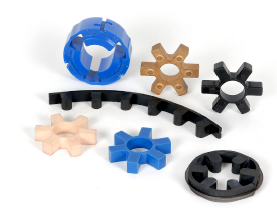Zhejiang Wenxian Gear Co., Ltd. | [email protected]
Jaw Elastomers Overview
Elastomers In Compression
We gives four types of elastomer styles to permit for supplemental flexibility in addressing specific application specifications. One particular piece types are used in the “L” and “AL” models (called spiders) and numerous component “load cushions” are utilized in the “C” and “H” model couplings. The load cushions are in sets of 6 to 14 pieces based upon coupling size.
Solid Center Spider
The solid center design is frequently applied style and design when shafts in the driver and driven tools is often kept separate by a standard gap
Open Center Spider
The open center design allows for your shafts with the driver and driven for being positioned within a quick distance
Open center spiders offer shaft positioning flexibility but possess a lower RPM capacity
Cushions
Utilized solely for the C and H Form couplings
Load cushions are held in spot radially by a steel collar which is attached to one of several hubs
Snap Wrap Flexible Spider
Design and style allows for effortless elimination in the spider without the need of moving the hubs
Allows for close shaft separation all of the way up to the hubs optimum bore
Maximum RPM is 1,750 RPM with all the retaining ring, but if utilised together with the LC Kind (with collar) the typical RPM rating in the coupling applies
Design is available in NBR and Urethane only, and in constrained sizes
Spider Resources
SOX (NBR) Rubber
The  common material that’s remarkably versatile materials that’s oil resistant
common material that’s remarkably versatile materials that’s oil resistant
Resembles all-natural rubber in resilience and elasticity, and operates successfully in temperature ranges of -40° to 212° F (-40° to 100° C)
Urethane
Has 1.5 instances greater torque capacity than NBR
Very good resistance to oil and chemicals
Material gives less dampening effect and operates at a temperature range of -30° to 160° F
Hytrel
Versatile elastomer designed for large torque and large temperature operations
Operates in temperatures of -60° to 250° F (-51° to 121° C)
Bronze
Rigid, porous, oil-impregnated metal insert exclusively for low pace (max 250 RPM) applications requiring higher torque capabilities
Not affected by water, oil, grime, or extreme temperatures – operates in temperatures of -40° to 450° F (-40° to 232° C)
